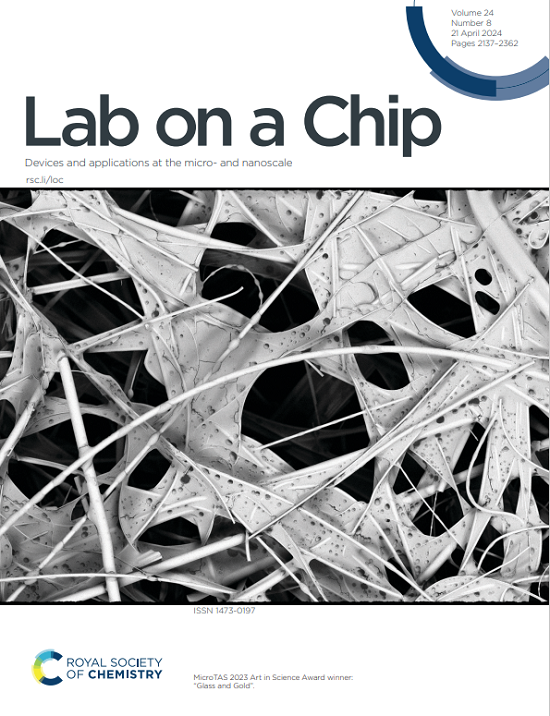血管化肿瘤芯片研究CAR-T细胞的免疫抑制。
IF 6.1
2区 工程技术
Q1 BIOCHEMICAL RESEARCH METHODS
引用次数: 0
摘要
嵌合抗原受体(CAR)-T细胞免疫疗法在血癌中有效,但在前列腺癌、胰腺癌和脑癌等实体肿瘤中表现出有限的成功,部分原因是免疫抑制肿瘤微环境(TME)。免疫抑制作用于多种细胞类型,包括肿瘤细胞、巨噬细胞和内皮细胞。传统的基于小鼠的模型与人类免疫学和癌症生物学的一致性有限。因此,我们开发了一个人类“肿瘤芯片”(TOC)平台,以高时空分辨率模拟免疫抑制元素。我们的TOC具有内皮细胞内衬通道,模仿体内毛细血管的特征,如细胞附着和外渗穿过内皮并进入TME。使用70 kDa葡聚糖和光漂白后荧光恢复(FRAP),我们确认了生理间质流动速度(0.1-1 μm s-1)。我们的装置表明,肿瘤源性因子可以沿与间质流动相反的方向扩散,到达200 μm外的内皮细胞,其浓度高达肿瘤边缘浓度的20%。m2样免疫抑制巨噬细胞和内皮细胞影响前列腺肿瘤细胞的生长、聚集和迁移。m2样巨噬细胞也诱导PD-L1并抑制邻近内皮细胞上ICAM-1基因的表达,这种模式限制了CAR-T细胞的外渗和效应功能。在抗pd - l1药物atezolizumab的存在下,这一观察结果被废除。这些结果为在实体肿瘤中有限的CAR-T细胞外渗和效应功能的体内观察提供了机制见解。此外,他们指出M2巨噬细胞在驱动CAR-T细胞迁移到TME和TME内的特定作用,并可能在开发新疗法以改善实体瘤CAR-T细胞疗法方面发挥作用。本文章由计算机程序翻译,如有差异,请以英文原文为准。
Vascularized tumor-on-a-chip to investigate immunosuppression of CAR-T cells.
Chimeric antigen receptor (CAR)-T cell immunotherapy, effective in blood cancers, shows limited success in solid tumors, such as prostate, pancreatic, and brain cancers due, in part, to an immunosuppressive tumor microenvironment (TME). Immunosuppression affects various cell types, including tumor cells, macrophages, and endothelial cells. Conventional murine-based models offer limited concordance with human immunology and cancer biology. Therefore, we have developed a human "tumor-on-a-chip" (TOC) platform to model elements of immunosuppression at high spatiotemporal resolution. Our TOC features an endothelial cell-lined channel that mimics features of an in vivo capillary, such as cell attachment and extravasation across the endothelium and into the TME. Using 70 kDa dextran and fluorescence-recovery-after-photobleaching (FRAP), we confirmed physiologic interstitial flow velocities (0.1-1 μm s-1). Our device demonstrates that tumor-derived factors can diffuse in the opposite direction of interstitial flow to reach the endothelium up to 200 μm away, and at concentrations as high as 20% of those at the tumor margin. M2-like immunosuppressive macrophages and endothelial cells affect prostate tumor cell growth, clustering, and migration. M2-like macrophages also induce PD-L1 and inhibit ICAM-1 gene expression on the adjacent endothelium in a pattern that limits CAR-T cell extravasation and effector function. This observation is abrogated in the presence of the anti-PD-L1 drug atezolizumab. These results provide mechanistic insight for in vivo observations showing limited CAR-T cell extravasation and effector function in solid tumors. Furthermore, they point to a specific role of M2 macrophages in driving CAR-T cell migration into and within the TME and could prove useful in the development of novel therapies to improve solid tumor CAR-T cell therapies.
求助全文
通过发布文献求助,成功后即可免费获取论文全文。
去求助
来源期刊

Lab on a Chip
工程技术-化学综合
CiteScore
11.10
自引率
8.20%
发文量
434
审稿时长
2.6 months
期刊介绍:
Lab on a Chip is the premiere journal that publishes cutting-edge research in the field of miniaturization. By their very nature, microfluidic/nanofluidic/miniaturized systems are at the intersection of disciplines, spanning fundamental research to high-end application, which is reflected by the broad readership of the journal. Lab on a Chip publishes two types of papers on original research: full-length research papers and communications. Papers should demonstrate innovations, which can come from technical advancements or applications addressing pressing needs in globally important areas. The journal also publishes Comments, Reviews, and Perspectives.
 求助内容:
求助内容: 应助结果提醒方式:
应助结果提醒方式:


